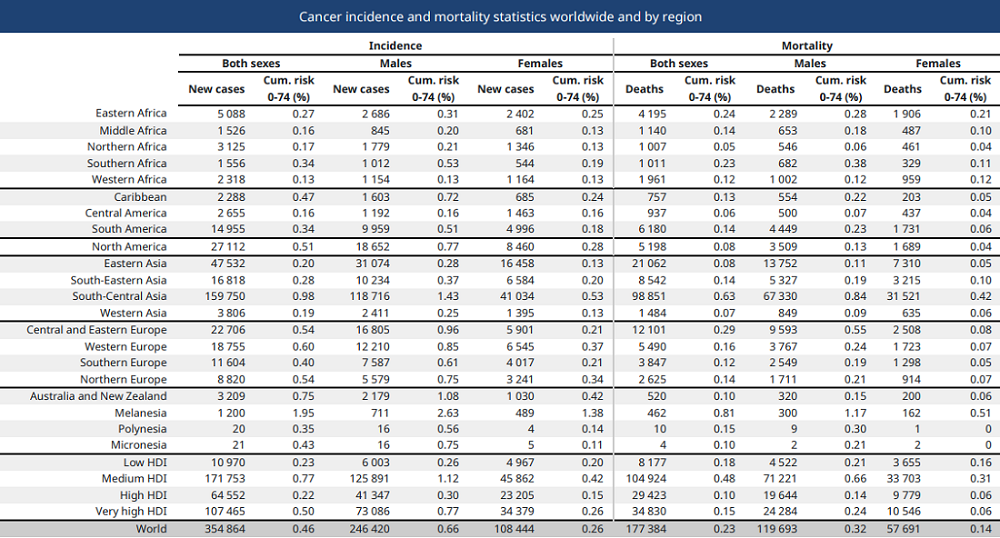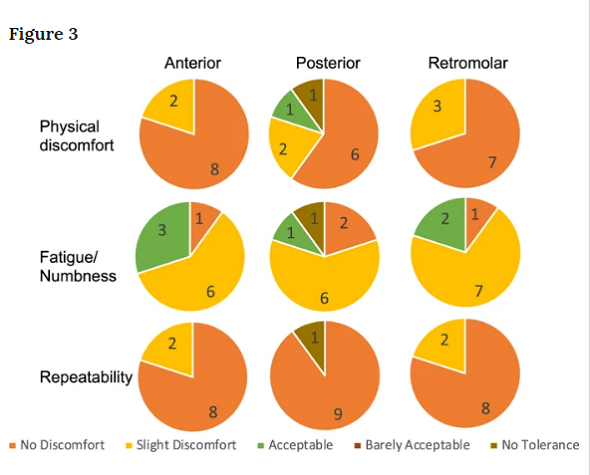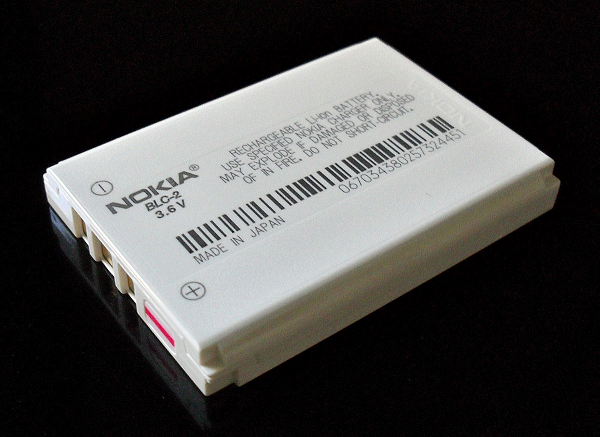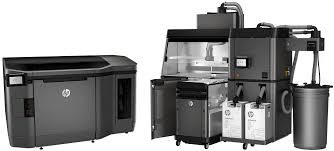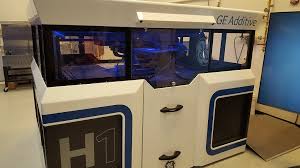3D Printing News Briefs, June 28, 2020: Autodesk, Sinterit, BCN3D Technologies
In today’s 3D Printing News Briefs, we’re talking about software and hardware. First, Autodesk has added a new generative design extension. Sinterit has made some changes so its printers are ready for Industry 4.0. Finally, a BCN3D Technologies 3D printer has been recognized as one of Spain’s best industrial designs.
Autodesk Generative Design Extension
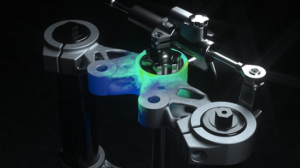
MJK Performance used generative design technology to create a set of lighter and stronger triple clamps for a drag bike
This week, Autodesk announced that it is allowing Fusion 360 users to take advantage of generative design capabilities more easily with the release of its new subscription offering – a generative design extension. This will give users complete access to Fusion 360 generative design for a separate subscription fee of $1,000 per month or $8,000 a year. Autodesk is now offering a special introductory price for a limited time only, so annual subscriptions to Fusion 360 and the new extension are available for 50% off the regular price through July 17th.
“We hear loud and clear that customers, especially these days, crave flexibility, and we’re more than happy to provide a solution at a price point that addresses their needs, especially for budget managers who require predictability. Most of all, we’re excited to see the momentum and incredible outcomes from casual users all the way up to major industry innovators or major brand innovators who are using generative design in the field,” said Stephen Hooper, vice president and general manager, Fusion 360.
Users can also access the generative design extension with their Autodesk Cloud Credits.
Sinterit 3D Printers Ready for Industry 4.0
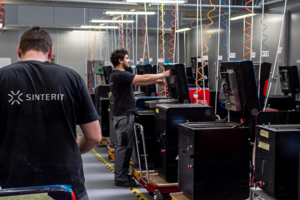 SLS 3D printer manufacturer Sinterit released a new software update that makes its Lisa and Lisa Pro 3D printers compliant with the Industry 4.0 standard, which works to automate integration with factory logistics. The update provides a new function that allows the printers to generate communication output regarding print status, in addition to a more intuitive user interface and a better tool for object collision detection.
SLS 3D printer manufacturer Sinterit released a new software update that makes its Lisa and Lisa Pro 3D printers compliant with the Industry 4.0 standard, which works to automate integration with factory logistics. The update provides a new function that allows the printers to generate communication output regarding print status, in addition to a more intuitive user interface and a better tool for object collision detection.
“We received questions from our clients about Industry 4.0 standards compatibility. For some of them, it was a must – a 3D printer without such compliance couldn’t be used,” explained Grzegorz Głowa, head of R&D department in Sinterit.
BCN3D Technologies Recognized for Epsilon 3D Printer
 Barcelona company BCN3D Technologies announced that its advanced BCN3D Epsilon 3D printer has been recognized by the FAD Association of Industrial Design as one of the best-designed products of 2019 in Spain. The printer has been shortlisted for the 2020 Delta Awards, and an independent jury of industry experts will announce the winner during Barcelona Design Week this November.
Barcelona company BCN3D Technologies announced that its advanced BCN3D Epsilon 3D printer has been recognized by the FAD Association of Industrial Design as one of the best-designed products of 2019 in Spain. The printer has been shortlisted for the 2020 Delta Awards, and an independent jury of industry experts will announce the winner during Barcelona Design Week this November.
“At BCN3D, we are design: we are meticulous, and our professional 3D printers are crafted after a long process of design and investigation to ensure that the end result is optimal. For us, this recognition is a reflection of the tremendous care we put in each product’s design and reflects on the work of every single member of the BCN3D team,” the company wrote in a blog post.
Discuss these stories and other 3D printing topics at 3DPrintBoard.com or share your thoughts in the Facebook comments below.
The post 3D Printing News Briefs, June 28, 2020: Autodesk, Sinterit, BCN3D Technologies appeared first on 3DPrint.com | The Voice of 3D Printing / Additive Manufacturing.
Scientists 3D print electrodes capable of detecting mycotoxins in food
Researchers Evaluate Comfort and Stability of 3D Printed Applicators for Oral Cancer Therapy
Oral cancer is on the rise around the world, and it’s especially bad in developing countries, such as Pakistan, Sri Lanka, and India, which don’t have the necessary medical infrastructure for early detection and treatment. A team of researchers from Boston and India explained in their paper, “Platform for ergonomic intraoral photodynamic therapy using low-cost, modular 3D-printed components: Design, comfort and clinical evaluation,” that there is “critical demand for an effective treatment modality that can be transparently adapted to low-resource settings.”
“The high expense and logistical barriers to obtaining treatment with surgery, radiotherapy and chemotherapy often result in progression to unmanageable late stage disease with high morbidity. Even when curative, these approaches can be cosmetically and functionally disfiguring with extensive side effects. An alternate effective therapy for oral cancer is a light based spatially-targeted cytotoxic therapy called photodynamic therapy (PDT),” the researchers wrote.
PDT uses a photosensitizer molecule accumulated in the tumor, and once it interacts with a specific light wavelength, it can cause targeted damage. It has few side effects, doesn’t cause disfigurement or loss of sensation, and has shown some good clinical results in terms of good post-treatment healing and epithelial necrosis. For regions with fewer medical resources, it would be very helpful to translate PDT therapy so it can be completed in an outpatient visit, and 3D printed oral applicators would be a great help on this journey.
“Despite excellent healing of the oral mucosa in PDT, a lack of robust enabling technology for intraoral light delivery has limited its broader implementation,” the team continued in their paper.
“Leveraging advances in 3D printing, we have developed an intraoral light delivery system consisting of modular 3D printed light applicators with pre-calibrated dosimetry and mouth props that can be utilized to perform PDT in conscious subjects without the need of extensive infrastructure or manual positioning of an optical fiber.”
The team’s goal in this study was to evaluate the clinical utility and ergonomics of their 3D printed oral PDT applicators, which were designed to comfortably, and stably, deliver light to patients’ oral lesions.
“Here, the natural structure of the patients’ oral cavity, teeth and jaw provided the support and stability to hold the fiber in place, avoiding any use of posts, holders, reflectors or light pipes,” the researchers explained.
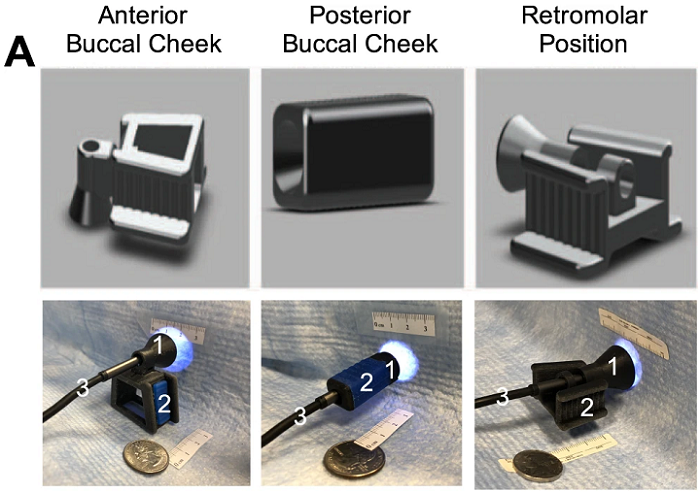
3D Schematics of the applicators for three different regions in the mouth. The photos showcase the integrated unit with the applicator (1), the bite wing (2) and the endoscope (3) utilized in the ergonomics clinical study.
The 3D printed intraoral applicators, which attach to the optical fiber, have two parts – bite blocks and applicators. The blocks position the angle of the applicator, which then delivers the suitable beam spot, along with pre-calibrated dosimetry, to a certain lesion size. The team used Autodesk Fusion 360 to design the light applicators, and they were printed on a Stratasys Objet Pro system out of VeroBlue and VeroBlack filament.
In order to determine how stable and comfortable the applicators were, the researchers performed a study, approved by the Massachusetts General Hospital Partners Institution Review Board, on ten subjects.
A physician placed three fiducial ink marks on each subject’s inner cheek, and tested the anterior and posterior buccal cheek and retromolar positions for ten minutes, one after the other. The light delivery fiber was replaced with an endoscope of similar size, with a 5.5 mm diameter camera and 6 LEDs, in order to record motion at these three spots.
The researchers explained, “Subjects were asked to rate comfort and fatigue on a numerical scale of 1 to 5 where 1 was no discomfort due to the applicator and 5 was intolerable discomfort due to the applicator.”
Each subject was asked three questions:
- Was there any physical discomfort during the ten minutes?
- Rate the fatigue or numbness in your mouth.
- Would you be comfortable immediately repeating another ten-minute interval at the same site?
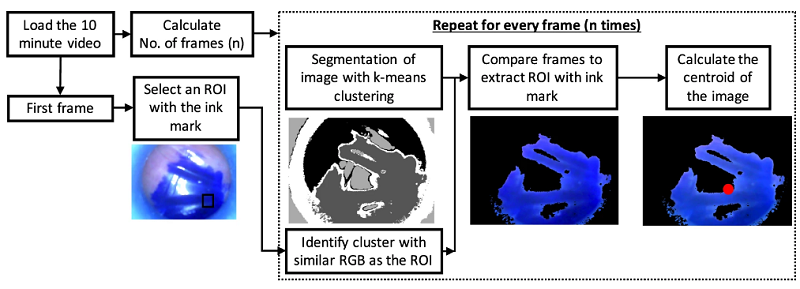
Flow chart of video and image processing method to calculate centroid of the fiducial ink mark mimicking the anterior buccal cheek, posterior buccal cheek or retromolar position imaged with a USB Endoscope fitted to the oral applicators.
Additionally, the endoscope actually recorded the movement of the ink marks during testing in order to evaluate the applicators’ stability. Custom-designed algorithms in MATLAB were used to process the videos. They determined that the applicators were indeed stable, and capable of “delivering light precisely to the target location in ten healthy volunteers.” Additionally, the ten subjects rated the devices overall as comfortable, though one did report “no tolerance” to the applicator in the posterior buccal cheek position.
Five of the subjects had confirmed T1N0M0 oral cancer lesions with no lymph node involvement, and several months after PDT treatment, demonstrated no cancerous lesions, fibrosis, or scarring. This showed that the 3D printed applicators, paired with an inexpensive fiber and LED-based light source, “served as a complete platform for intraoral light delivery achieving complete tumor response with no residual disease at initial histopathology follow up in these patients.”
“While we used a set of applicators with pre-determined sizes that were comfortable for various subjects, mouth and jaw dimensions and genders, it is reasonable to envision extension of this approach to customized patient treatment. Specifically, personalized applicators can be rapidly printed at the time of procedure due to advances in image-based 3D printing and the increasing availability of low-cost, high-quality 3D printers in clinical settings,” the researchers concluded.
“The ergonomic design of 3D printable light applicators has significant practical benefit in enabling longer irradiation duration and improved accuracy of light delivery necessary for curative PDT. With costs of healthcare and cancer incidences increasing worldwide, particularly in developing countries, we report an affordable methodology for delivering light stably and ergonomically in the oral cavity which can be used in conjunction with a low-cost, portable, battery-powered fiber-coupled LED based light source.”
This is just one more good example of 3D printing successfully being used for cancer therapy.
Co-authors of the paper are Srivalleesha Mallidi, Amjad P. Khan, Hui Liu, Liam Daly, Grant Rudd, Paola Leon, Shakir Khan, Bilal M. A. Hussain, Syed A. Hasan, Shahid A. Siddique, Kafil Akhtar, Meredith August, Maria Troulis, Filip Cuckov, Jonathan P. Celli, and Tayyaba Hasan.
Discuss this and other 3D printing topics at 3DPrintBoard.com or share your thoughts below.
The post Researchers Evaluate Comfort and Stability of 3D Printed Applicators for Oral Cancer Therapy appeared first on 3DPrint.com | The Voice of 3D Printing / Additive Manufacturing.
Link3D expands EOS partnership, enters collaboration with Autodesk and AMFG
Researchers Tailor Graphene Content in Bespoke Filament for 3D Printed Porous Anodes in Batteries
Long-lasting, rechargeable lithium-ion (Li-ion) batteries have a high energy density and low self-discharge, and are finding their way into aerospace and military applications, among others. As the demand for energy consumption rises at the same time the pressure for reducing our usage of fossil fuels is, our society is working hard to find innovative ways of manufacturing energy storage devices.
3D printing has been used in the past to fabricate porous electrodes for lithium-ion batteries, and even the batteries themselves. A collaborative group of researchers from Manchester Metropolitan University, China’s Central South University, and the University of Chester recently published a paper, titled “Next-Generation Additive Manufacturing: Tailorable Graphene/Polylactic(acid) Filaments Allow the Fabrication of 3D Printable Porous Anodes for Utilisation within Lithium-ion Batteries,” about their work applying Li-ion anodes within 3D printed Li-ion batteries, made with a bespoke graphene/PLA filament that allows the graphene content to be easily tailored.
The abstract reads, “We demonstrate that a graphene content of 20 wt. % exhibits sufficient conductivity and critically, effective 3D printability for the rapid manufacturing of 3D printed freestanding anodes (3DAs); simplifying the components of the Li‐ion battery negating the need for a copper current collector. The 3DAs are physicochemically and electrochemically characterised and possess sufficient conductivity for electrochemical studies. Critically, it is found that if the 3DAs are used in Li‐ion batteries the specific capacity is very poor but can be significantly improved through the use of a chemical pre‐treatment. Such treatment induces an increased porosity, which results in a 200‐fold increase (after anode stabilisation) of the specific capacity (ca. 500 mAh g−1 at a current density of 40 mA g−1). This work significantly enhances the field of additive manufacturing/3D printed graphene based energy storage devices demonstrating that useful 3D printable batteries can be realised.”
Many researchers are working with novel nanomaterials like carbon nanotubes and graphene for the purposes of 3D printing novel energy storage devices, such as Li-based batteries, as the technology can be used to create structures with a large surface area – helpful when it comes to energy capabilities. This particular team used FDM (extrusion-based) technology to create Li-ion anodes out of bespoke 3D printable graphene/PLA filaments. They also performed electrochemical and physicochemical characterization, to make sure that the graphene content was optimized for controlling the conductivity, electrochemical activity, and 3D printability of their 3D printed freestanding anodes, or 3DAs.
The researchers stated that “…this approach simplifies the components of the Li‐ion battery negating the need for a copper current collector.”
The team used Autodesk Fusion 360 to create the 3D printed designs for this work – a circular disc electrode, 1.0 mm thick, with a range of diameters – and printed them at 190 °C, with a direct drive extruder, on a ZMorph 3D printer. The 3D printable graphene/PLA filaments were made with a range of 1, 5, 15, 20 and 40 wt.% graphene nanoplatelets, which were validated using thermogravimetric analysis (TGA).

Physicochemical characterisation and optical images of the graphene/PLA powders, respective filaments and 3DAs. A: Thermogravimetric analysis, B: Resistivity vs. graphene content, C: TEM analysis of 20 wt. % graphene/PLA, D: 3D printing process of the 3DAs (for electrochemical characterisation), E: Raman (inset) and Raman Mapping of the 3DA.
“In brief, the fabrication of graphene/PLA filaments containing percentages over 20 wt. % are extremely brittle and highly unreproducible in terms of both homogeneity, printability and structural integrity; additionally filaments with a wt. % of graphene below 10 % did not offer sufficient percolation (i. e. high resistivity),” the researchers wrote.
“Therefore, we have found that 15–20 % is the optimal wt. % when one is considering graphene nanoplatelets…where the resistivity decreases and conductivity increases.”
After they optimized the graphene content, the team used the filament with 20 wt. % graphene to 3D print test anodes for more physicochemical characterization. They also completed a Raman analysis on the anodes, as well as an XPS analysis; the latter involved taking high-resolution scans “over the C 1s and O 1s photoelectron peaks,” which were broad and strangely shaped. The analysis showed that PLA was present in two forms, at roughly the same levels, as in the graphene/PLA samples.
“In summary, XPS analysis reveals that the high volume of graphene within the graphene/PLA filament is fully dispersed within the PLA creating a conductive pathway throughout the sample, thus corroborating with aforementioned electrochemical and physicochemical characterisation,” the researchers wrote.

SEM images of a typical graphene 3DA pre‐ and post‐NaOH chemical treatment displaying their respective charge‐discharge profiles. The setup used to test the anodes is simpler over traditional coin cells as no copper current collector is required.
Finally, the team evaluated the energy capabilities of the 3DAs in a Li-ion battery setup, and found that that the graphene 3DAs have a relatively low electrochemical response. To further understand, they analyzed the graphene 3DA’s topography, which showed that its surface doesn’t have good porosity for wetting electrolytes. By introducing a simple chemical pre‐treatment of NaOH to the 3DAs for 24 hours, the researchers were able to induce porosity and get past this limitation.
To further understand, they used X-ray diffraction to analyze the crystalline structure of the graphene/PLA both before and after this pre-treatment, explaining that the SEM images and XRD patterns show that the material didn’t lose its 3D structure, “but now offers an excellent electrochemical behaviour/performance.”
“…we suggest that the graphene incorporated within the 3DA, is predominantly graphene‐like in its electrochemical behaviour, and that the increased surface area of the graphene nanoplatelets within the composite provide the improved energy outputs,” the researchers stated. “The results presented herein enhances the field of additive manufacturing/3D printed graphene‐based energy storage devices with the utilisation of a tailorable graphene/PLA filament, and with a simple chemical treatment of the 3D printed anode can exhibit a 200‐fold increase within the specific capacity (after anode stabilisation).”
The team determined that the 3D printed freestanding anodes with a 20 wt. % graphene content had the most effective 3D printability and conductivity.
“The results presented herein significantly enhance the field of additive manufacturing/3D printed graphene based energy storage devices demonstrating that useful 3D printable batteries can be realised,” the paper concluded.
Co-authors are Dr. Christopher W. Foster, Dr. Guo‐Qiang Zou, Yunling Jiang, Dr. Michael P. Down, Dr. Christopher M. Liauw, Alejandro Garcia‐Miranda Ferrari, Prof. Xiaobo Ji, Prof. Graham C. Smith, Prof. Peter J. Kelly, and Prof. Craig E. Banks.
Discuss this research, and other 3D printing topics, at 3DPrintBoard.com or share your thoughts below.
Interview with Alexander Oster of Autodesk
Alexander Oster is an extremely knowledgeable 3D printing person. If we’re looking at mesh repair or 3D printing files & software I’d consider Alexander the number one person worldwide. He also has a lot of manufacturing experience and this combined with his thorough knowledge of 3D printing software means he’s a veritable one man army in 3D printing. Alexander got started at one of the first 3D Printing service bureaus FIT (who pioneered SLA prototyping, prosthetics and manufacturing with 3D printing) singlehandedly wrote most of Netfabb and worked on some of the earliest 3D printing checking and pricing software. When Netfabb was acquired by Autodesk he moved to the company to become their Director of Additive Manufacturing. Alex is a great guy as well and has some very real nuanced insight to share with us.

Alexander Oster
How did you get into 3D printing?
I came in contact with 3D printers for the first time in 1998, when I had a student job at a local company that acted as Prototyping Service Provider for the Southern German Automotive Industry. At the time, they used this completely new and mind-blowing technology called Stereolithography in order to make prototypes and molds for investment casting.
The new thing about this method was that overnight it transformed the old craftmanship of model-making into a completely digital and high-tech activity – and there was almost no existing software stack available that would support this change. I had a good chunk of experience in programming 3D games, experience which we leveraged to help write a lot of in house software to keep the process working and efficient.
This company, FIT AG, still exists today and has become one of the premier additive contract manufacturers in Europe.
You wrote one of the first online software for 3D printing, what was that like?
Back in 2004, we mostly focused on the Design and Manufacturing of latticed part geometries years before everybody else sold this as “news”. For example, at the annual Euromold trade show 2006 we had a real size (about 3x3x3 meter) latticed tree on display – which was printed in Nylon and very lightweight due to its nature-inspired internal geometries.
It was unthinkable to do this in a CAD system at the time, so we had to find some shortcuts to directly create laser paths for use by the EOS plastic systems to handle the data appropriately.
But for our original geometry representation we still used (as did everybody else) triangles that were stored in the STL format. As this created a lot of instabilities and handling problems, we were forced to develop repair and fixing algorithms to mediate that. At this point, we did not make a commercially sellable product, but it was enough to be useful for others. So we released it as cloud service, and then cooperated with the newly founded Shapeways to streamline their customer upload process.
By coincidence this was also the time when the RepRap project and especially a small New York startup called Makerbot set out to make 3D Printing a known technology for the masses. Like in the industrial world, each one of those new 3D Printer users had a dire need to process all kinds of broken and invalid geometry files from a plethora sources – and this made the netfabb Cloud Services quite popular.
After a few years, we were very honored and excited that Microsoft took up the service as one of the first on their Azure platform; and connected it to the newly released Windows 10, with its built-in 3D Builder app.

You also wrote Netfabb, how has its functionality expanded?
Netfabb was the desktop version of this cloud service, and today has grown from a small tool that prepared STL files for 3D printing to a fully blown end to end solution for Additive Manufacturing. Particularly since our acquisition by Autodesk, we were able to quickly leverage the full force of a software giant and incorporate CAD kernels, Metal Process Simulation, Finite Element Solver, and advanced cloud capabilities. The whole software is now a puzzle piece in the much larger Autodesk Manufacturing world consisting of top-end vertical solutions for all each imaginable process of Digital Manufacturing – whether it be CNC operations (Autodesk PowerMill), composite manufacturing and cutting (Autodesk TruNest), or injection molding simulation (Autodesk MoldFlow).
This broadness of capabilities makes the Autodesk solution portfolio very unique in the market, and our tiered packaging model really has changed various developments in the industry. For example, at an entry-level price of only 200 US dollars per year we directly support hundreds of different 3D printers, affordable providing everybody in an organization access to 3D Printing data preparation. At the same time our high-end manufacturing and simulation solutions power the most advanced industrial applications on the planet.
What has changed in 3D printing industry during the time you were involved with it? Is the software landscape different now?
The major change between today and a decade ago is that nowadays a lot of large industrial players are investing huge amounts of capital, and new startups easily receive millions of dollars of venture funding with a well-presented idea that only exists on paper.
I am not sure if this is as bad as in other areas like Blockchain or Artificial Intelligence – but it has in my opinion skewed the market quite a lot and we are often seeing behind the scenes new entrants that are remaking all the mistakes that have already been made 10 years ago. This sometimes makes one feel sorry for all the lost money, but it also ensures that life stays exciting and it is not absolute that the most capital equipped player will in the end win the market.
From a software perspective, we are basically seeing what some people have predicted long time ago, which is basically the fact that the major large CAD vendors moved in and are incorporating 3D printing solutions into their products – and will in the long term dominate the software field. This is kind of unavoidable due to the important link between the design process of parts and the manufacturability constraints that naturally come with Additive Manufacturing.
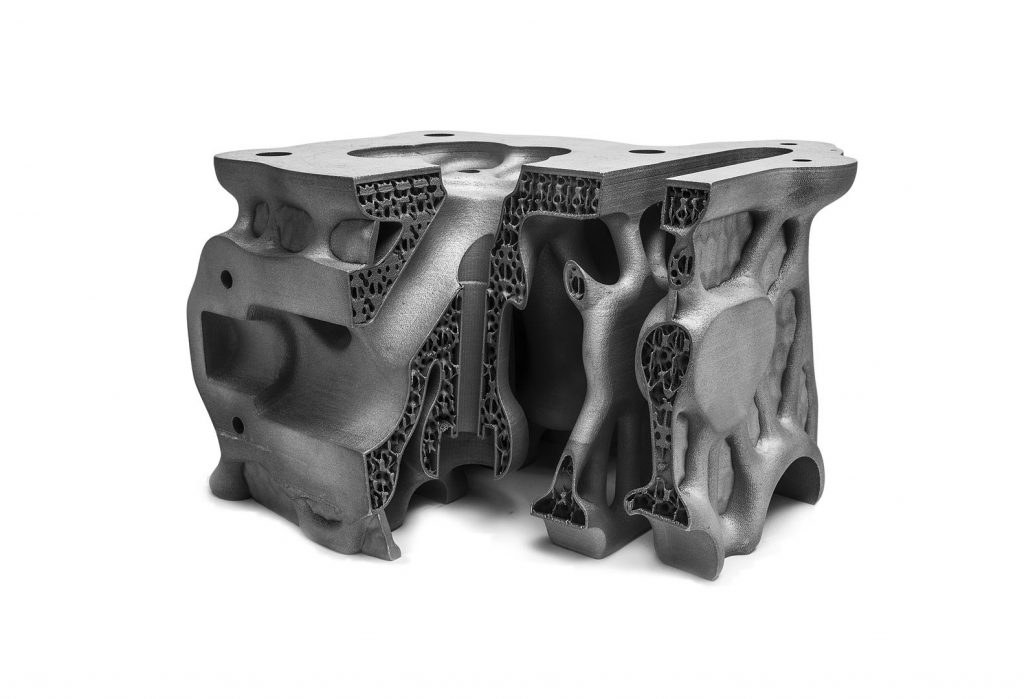
What are Autodesk’s plans with 3D printing?
In addition to all of our Netfabb activities, I am specifically excited about our movement to integrate our manufacturing capabilities into Fusion 360. Fusion 360 is Autodesk’s next generation cloud-connected Design-to-Make platform, supporting all steps of the product development process, from conceptual design, mechanical design, CAE, CAM, and data management. And all of this backed by a cloud system that makes collaboration across different continents as effective as sitting next to each other.
A few months ago, we have released the first iteration of our Metal Additive capabilities inside of Fusion 360. Next to the established Fusion CAM module, this gives an amazing in-CAD experience for the user to quickly get from a design environment to a print ready file within seconds, and at the same time create the CNC postprocessing operation for the same part.
It is truly exciting to see the possibilities and the convergence of the design process of a product with the downstream manufacturing chain. And all of this in one place and in an associative way – which means once there is a change done upstream to the original design the manufacturing instructions are automatically updated accordingly. And all of this can be accessed at a subscription prices that will open up those capabilities to a vast group of designers and engineers who could not have afforded a fraction of capabilities before.
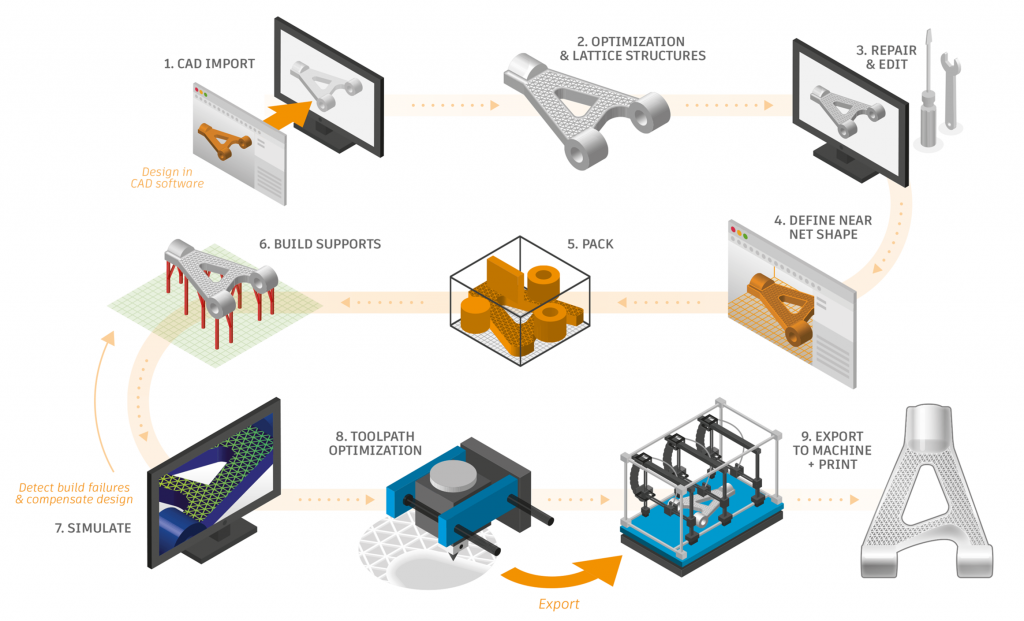
What do you see as the major roadblocks to 3D printing adoption?
While a lot of people still think about the quality aspects of Additive Manufacturing as the main issue, in my opinion the problem is more that the current cost structure of the technologies is far too expensive to make them viable in the mainstream. If the costs per part would be significantly lower, a lot of applications would open up where the quality problems we are seeing would be less relevant – casting for example has at least as many issues as additive, but is viable and widely used.
A lot of companies today are trying to reduce the costs by increasing production speed. This certainly helps, but in my opinion the real elephant in the room is the capital investment needed to really make use of the technology. You can easily find an entry level CNC equipment, and industrial robot or a state of the art injection molding machine for less than 50.000 US dollars, but one still requires millions of dollars to set up an efficient Additive Manufacturing operation, and even more millions to train engineers to properly take advantage of the process. Based on the amount of capital, this often means a lot of produced parts must be producted in order to amortize and therefore creates a high barrier for applications that are most suitable for 3D printing (i.e. the ones that have a low life time unit count).
The big democratization of 3D Printing has already occurred for stereolithography and FDM market, and I am sure we will also see it for the more industrial technologies too. And it will finally make the technology mainstream enough that the knowledge about them becomes ubiquitous.
What advice would you give me if I was an industrial company wanting to get started with 3D printing?
Do not invest millions of dollars in a in house technology park that will be outdated in a few years. Rather invest the money in product development together with a manufacturing partner and design consultants that can train you how to apply 3D Printing in the best way for your application.
How do you think that 3D printing could make a real impact on companies bottom lines?
I think this is not the right question, as this is always suggesting that we will build current products just a little bit cheaper when we 3D print them. In my opinion, the real question is much more which developments will not happen and which new businesses cannot be built without a major contribution of 3D Printing technology. And there the list is quite extensive.
I do not believe patient-specific implants are feasible without 3D Printing. I also believe there will be no walking robots without 3D printed components and no flying taxis. Or if you look at the current developments in the aerospace industry, we will not go to Mars without Additive Manufacturing involved, nor will we achieve environmentally sustainable air travel. Climate Change challenges, in general, will be very hard to tackle. If you look at the construction market for example, the amount of buildings the world needs to build in the coming decades for the billions of people moving into the middle class is mind-blowing. Neither enough resources nor the human capacity exists today to achieve this without destroying the planet. I do not believe that this will work out without proper automation, and advances in robotics and 3D printing will certainly play a key role in this. Dubai for example recently passed a law that 25% of its new buildings need to be 3D printed by 2025.
Independent how that will turn out, the future certainly will be exciting.
Autodesk Works with HP and GE Additive to Develop End to End Design-to-Print Workflows
Autodesk has developed a new generative design software that works directly with HP Multi Jet Fusion 3D printers. The design-to-print workflow for additive manufacturing was designed specifically for HP’s 3D printers, with the goal of streamlining the conversion of digital design to physical part.
“The HP multi-jet fusion printers are changing the value equation when it comes to 3D printing for production. The plastic printers are now becoming cost-efficient versus injection molding for part counts in excess of 10,000 parts,” said Robert Yancey, Director of Manufacturing Industry Strategy at Autodesk. “The new metal printers promise to have similar value benefits compared to metal injection molding. HP is helping move the additive manufacturing market from prototyping to production applications.
“HP multi-jet fusion printers promise higher volumes and higher customization than plastic printers that have been in the market for some time. To unlock the full value of HP MJF printers, you need a good design, a good material, and a good print process. Autodesk develops the design tools and technology, HP develops the print process, and HP with their material partners develops the materials. All aspects are required to achieve maximum efficiency.”
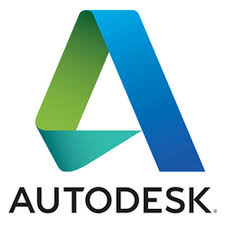 Penumbra Engineering is a generative design company that is a client of both Autodesk and HP. Not long ago, the company was asked by a client to design and 3D print a new ultrasonic sensing device with both accuracy and the durability to withstand use in extreme environments. Penumbra used Autodesk generative design software along with HP Multi Jet Fusion 3D printers to create a lightweight, balanced design that met strict performance requirements and ensured stability and ease of use in the field.
Penumbra Engineering is a generative design company that is a client of both Autodesk and HP. Not long ago, the company was asked by a client to design and 3D print a new ultrasonic sensing device with both accuracy and the durability to withstand use in extreme environments. Penumbra used Autodesk generative design software along with HP Multi Jet Fusion 3D printers to create a lightweight, balanced design that met strict performance requirements and ensured stability and ease of use in the field.
“The Penumbra case study uncovers the value of HP working with Autodesk generative design technology,” said Yancey. “We’re supporting HP printers in Fusion 360 and Netfabb so that HP multi-jet fusion customers have the design and print prep tools they need. We’re working with HP to provide support for the new metal printers they recently announced.”
In addition to working with HP, Autodesk is also working with GE Additive to create an integrated workflow for GE 3D printers. The workflow will be based on the Fusion 360 platform and will connect all stages of the additive manufacturing process. Autodesk is using GE Additive software algorithms, interfaces and specialized data models to offer predictive insights. The workflow will also provide cost and timeline projections in the early stages of design so that engineers can make decisions without physically producing the parts first.
“Working with Autodesk will provide a powerful design-to-print environment for our customers, helping lower the barriers of additive adoption while accelerating a customer’s time to first good part,” said Lars Bruns, Software Leader at GE Additive.
GE and its customers currently have to use multiple software products and data formats to go from concept to 3D printed part, so the company wanted to develop a complete end-to-end workflow for its Direct Metal Laser Melting machines within Fusion 360.
“The GE and Autodesk collaboration has the goal of providing a single platform and environment for users to conceive of a part design using Fusion 360, which includes generative design,” said Yancey. “The platform will simulate that design, print the design, and capture all of the relevant print data to store with the design file so we have a single source of truth for each printed component.”
GE will share preliminary cost data to generative design studies so that users can compare cost variations between the options in addition to engineering and weight variations.
“This will significantly increase the value of generative design by giving users an environment to quickly assess both engineering and business tradeoffs for the many options generated,” said Yancey.
Discuss this and other 3D printing topics at 3DPrintBoard.com or share your thoughts below.
[Source: Design News]
3D Printing Mythbusting with Braille Skateboarding
A Generatively Designed Skateboard from Fusion 360 and Shapeways
Industrial Designer Paul Sohi is obsessed with 3D printing. He’s made it his life’s work to make it accessible to more people – a mission we share. His earlier efforts include developing the world’s first fully additively manufactured prosthetic used at the Paralympic Games. More recently, he has been evangelizing for Fusion 360 at Autodesk.
A skateboard was ideal for Paul’s latest project. He wanted to design a fun, common item to debunk many 3D printing myths still common today by proving that 3D-printed products are end-use ready, durable and not just for prototyping. Just as important, Paul wanted to prove that you don’t have to buy a 3D printer. He explains, “The number one misperception I hear from designers is that they have to buy a 3D printer. I want to show that Shapeways’ services are part of the Fusion 360 workflow.”
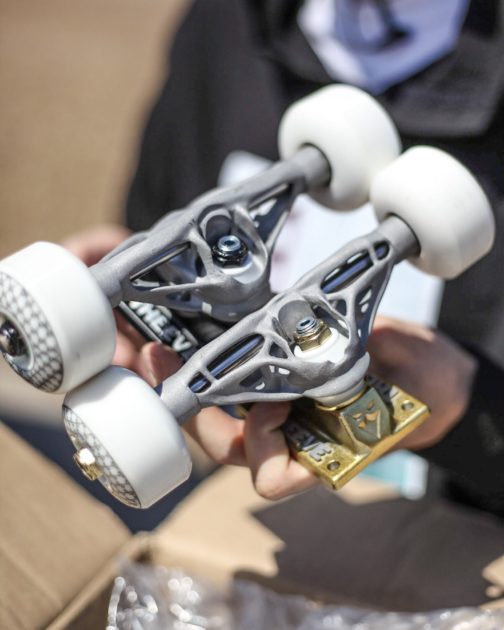
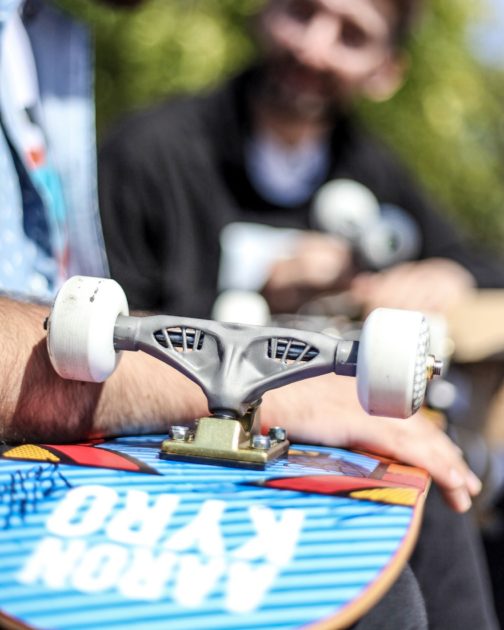
Paul used Fusion 360 Generative Design to make the skateboard trucks (the metal T-shaped pieces that mount onto the underside of the skateboard) durable while also minimizing materials to cut costs. He sent the files to Shapeways, and we delivered the trucks in two materials: titanium and aluminum, both manufactured using additive manufacturing. Paul constructed the entire skateboard from board to wheels to trucks, and headed to California.

Braille Skateboarding was founded by Aaron Kyro and creates videos to help spread the joy of skateboarding. They joined the project to see if Paul’s skateboard trucks could enhance Braille’s tricks. We wanted to show the skate trucks’ functionality all while capturing some great runs on a board made possible with 3D printing and generative design. More than just a 3D printing stunt, our team wanted to focus on making skateboarding an even better experience with increased durability and mobility. We succeeded – Paul estimates the trucks are 35% lighter and twice as durable versus comparable skateboard trucks.
We captured videos of Braille’s tricks and details on how the skate trucks were made. Special thank-you to Paul, Braille, and Autodesk for making this so much fun. Shapeways loved helping to bring this idea to life.
The post 3D Printing Mythbusting with Braille Skateboarding appeared first on Shapeways Magazine.

